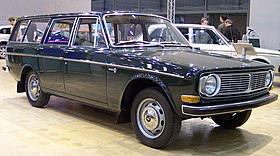Volvo 145
| Volvo 140 Series | |
|---|---|

Volvo 145
|
|
| Overview | |
| Manufacturer | Volvo Cars |
| Production | 1966–1974 |
| Assembly | Sweden: Torslanda (Torslandaverken) Belgium: Ghent (VCG) Canada: Halifax (VHA) Australia: Melbourne, Victoria Malaysia: Shah Alam (SMA) |
| Body and chassis | |
| Class | Compact executive car |
| Body style | 2-door sedan 142 4-door sedan 144 5-door station wagon 145 |
| Layout | FR layout |
| Related | Volvo 164 |
| Powertrain | |
| Engine |
|
| Dimensions | |
| Wheelbase | 102.5 in (2,604 mm) |
| Length | 183.1 in (4,651 mm) 144 sedan 1973 |
| Width | 68.1 in (1,730 mm) 144 sedan 1973 |
| Height | 56.7 in (1,440 mm) 144 sedan 1973 |
| Curb weight | between 2,580 lb (1,170 kg) (142 base model) and 2,898 lb (1,315 kg) (145 de Luxe) |
| Chronology | |
| Predecessor | Volvo Amazon |
| Successor | Volvo 240 |
The Volvo 140 Series is a line of mid-size cars manufactured and marketed by Volvo from 1966-1974 in two- and four-door sedan (models 142 and 144 respectively as well as five door station wagon (model 145) body styles — with numerous intermediate facelifts. More than a million Volvo 140s were built.
Volvo Cars began manufacturing the Volvo 144 at Torslandaverken in the late summer of 1966 for the 1967 model year. The 144 series, which followed the Volvo Amazon (replacing it in its 4th model year), was the first Volvo to use a tri-digit nomenclature, indicating series, number of cylinders and number of doors. Thus, a "144" was a 1st series, 4-cylinder, 4-door sedan. The 144 was the first Volvo to feature a more rectilinear or boxy styling. Compared to the Volvo Amazon, the 140 was a radical departure with minimal exterior and interior carryover, notably a stylised version of the front split grille. The car's basic shape would survive into the 1990s as the 200 series. Mechanically, the car used many of the same drivetrain components as the Amazon, but also showcased many improvements, including disc brakes on all four wheels. It was named car of the year in 1966 by Swedish magazine Teknikens Värld. The engine in the standard 144 was the same as found in the standard Amazon (121), the 1.8l B18A, but the 144S was given the more powerful B18B from the 123GT and 1800S. Late in the 1967 model year production of the Volvo 142 (2-door sedan) began, in time to build 1500 units for the first year. In 1968 production of the Volvo 145 5-door station wagon began, completing the three body styles used in the 140 range.
For the 1969 model year Volvo enlarged the B18 to become the 2.0 litre B20 and replaced the generator with a more modern alternator. It was also in 1969 that Volvo introduced the 164, which shared much of the 140 series structure and styling aft of the windshield while incorporating a 6-cylinder engine, the B30 which was simply a B20 with 2 more cylinders and a few strengthened and enlarged components. Volvo also introduced the Express this year (see below).
...
Wikipedia
